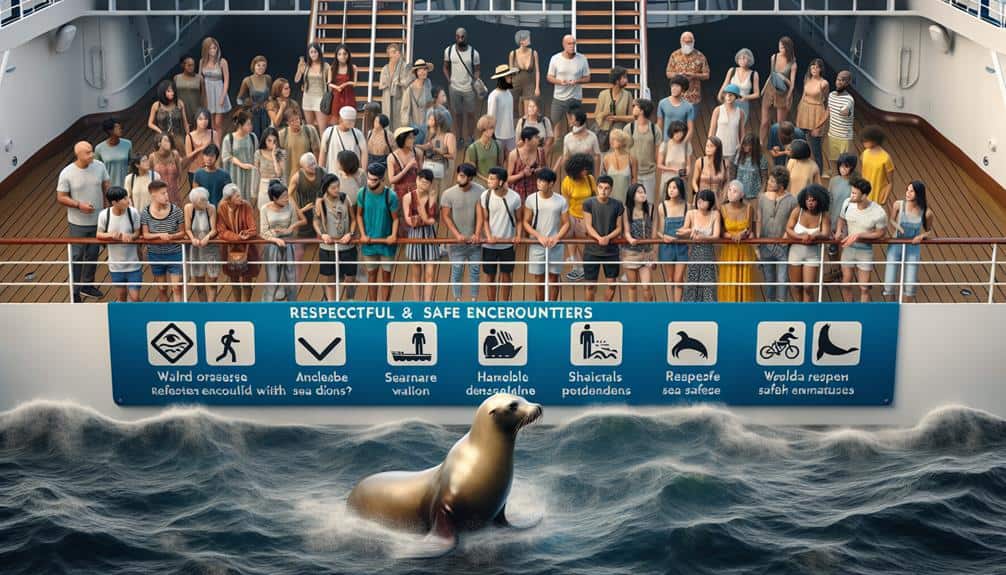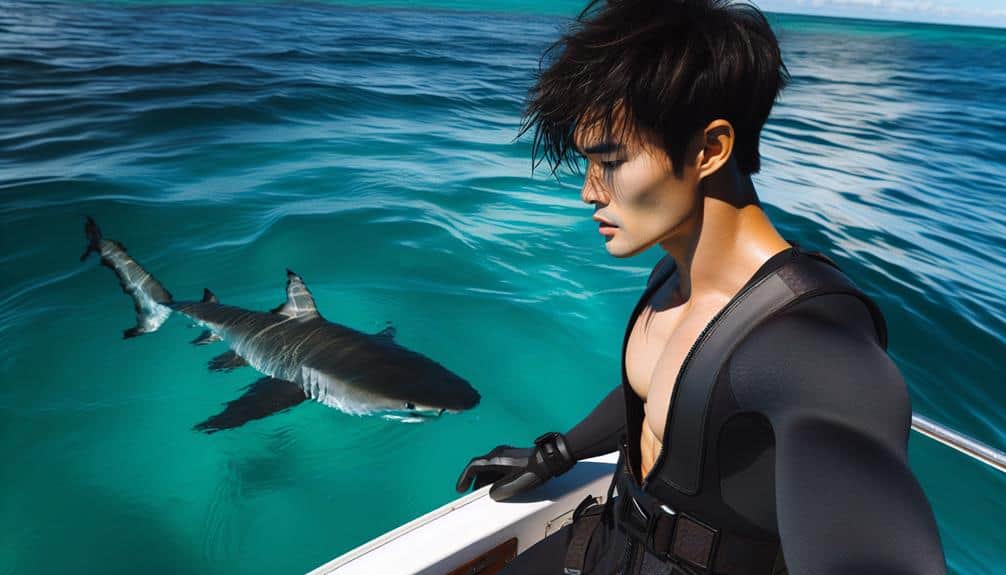To safely encounter sea lions on cruises: observe their body language for cues, stay 10-15 feet away, move slowly without sudden actions, respect their environment, and know when to back off if they show signs of stress. Following these guidelines guarantees a positive interaction with these marine mammals.
Key Points
- Maintain a distance of 10-15 feet to respect their space and reduce stress.
- Avoid sudden movements, loud noises, and direct eye contact to prevent startling them.
- Use proper observation techniques, natural light, and zoom for photography etiquette.
- Respect their environment by minimizing disturbances and choosing eco-friendly practices.
- Know when to retreat by observing body language and signs of discomfort for a safe interaction.
Understanding Sea Lion Behavior
To safely encounter sea lions on cruises, understanding their behavior is essential. Observing body language is key in determining a sea lion's mood and intentions. When a sea lion is relaxed, you'll notice it lying with its flippers outstretched, possibly yawning or scratching itself. This indicates that the sea lion isn't feeling threatened and is comfortable in its current environment.
On the other hand, if you observe a sea lion growling, barking, or displaying aggressive postures such as arching its back or showing its teeth, it's best to back away slowly to establish boundaries and avoid any potential conflict.
Establishing boundaries with sea lions is important for ensuring a safe encounter. Avoid getting too close to them or making sudden movements that may startle or provoke them. Respect their space and refrain from attempting to touch or feed them. By maintaining a safe distance and being mindful of their body language, you can observe these fascinating creatures in their natural habitat while keeping yourself and the sea lions safe.
Maintaining a Safe Distance
Maintain a safe distance from sea lions during encounters to guarantee the well-being of both yourself and the animals. When observing sea lions, it's essential to employ proper observation techniques to assure a safe interaction. Keep a distance of at least 10-15 feet from the animals to minimize stress and prevent any potential disruptions to their natural behavior. By maintaining this distance, you can observe the sea lions without causing them distress or feeling threatened.
Additionally, if you're taking photographs during the encounter, it's vital to follow appropriate photography etiquette. Avoid using flash photography, as it can startle the sea lions and disrupt their natural environment. Instead, use natural light and zoom capabilities to capture stunning images while respecting the animals' space.
Avoiding Sudden Movements
When encountering sea lions, it's crucial to refrain from making sudden movements to guarantee a safe and harmonious interaction with the animals. Sudden movements can startle sea lions and lead to unpredictable behavior, potentially resulting in defensive reactions.
To guarantee a positive experience when interacting with these marine mammals, follow these precautionary measures:
- Move Slowly: Approaching sea lions with slow and deliberate movements helps convey a sense of calm and non-threatening behavior, reducing the chances of startling them.
- Avoid Direct Eye Contact: While maintaining a calm demeanor, sea lions may perceive direct eye contact as a challenge or threat. Instead, look in their direction without staring directly into their eyes.
- Refrain from Loud Noises: Sea lions have sensitive hearing and can be easily startled by loud noises. Keep conversations at a moderate volume and avoid sudden loud sounds to maintain a peaceful environment during the encounter.
Respecting Their Environment
Respect the natural habitat of sea lions by being mindful of your surroundings and minimizing disturbances to guarantee a harmonious coexistence during your encounter. When approaching sea lions in their environment, it's important to prioritize responsible tourism practices. Minimizing pollution is vital to safeguarding the marine ecosystem that these magnificent creatures call home. Make sure that no litter or harmful substances are left behind during your visit to their habitat.
Responsible tourism involves respecting the delicate balance of nature and minimizing your impact on the environment. Avoid using single-use plastics that can harm sea lions and other marine life through ingestion or entanglement. Opt for eco-friendly alternatives and dispose of waste properly to prevent pollution of the sea lion habitat. By adopting these practices, you contribute to the preservation of the natural beauty and biodiversity of the oceans, fostering a sustainable environment for sea lions and future generations to enjoy.
Knowing When to Retreat
To guarantee a safe and respectful interaction with sea lions during your cruise, it's essential to recognize when it's appropriate to withdraw from their vicinity. Sea lions, while fascinating creatures, require space and respect to thrive in their natural habitat. Here are three important points to keep in mind when knowing when to retreat:
- Recognizing boundaries: Sea lions, like all wildlife, have their boundaries. It's important to maintain a safe distance to avoid causing stress or agitation to the animals. If a sea lion displays signs of discomfort, such as vocalizing loudly, showing teeth, or making sudden movements, it's time to retreat to a safer distance.
- Observing body language: Sea lions communicate through body language. Pay attention to their movements and postures. If a sea lion starts to exhibit signs of aggression, such as arching its back, raising its head, or making direct eye contact, it's best to retreat slowly and calmly to prevent any potential conflict.
- Respecting their space: Remember that sea lions need their space to rest, socialize, and hunt. If you notice a sea lion showing signs of stress or disturbance, such as moving away, vocalizing in distress, or becoming tense, it's important to retreat promptly to allow them the peace they require. By recognizing these boundaries and observing their body language, you can ensure a safe and harmonious interaction with these magnificent creatures.
Frequently Asked Questions
What Should I Do if a Sea Lion Approaches Me While I Am on a Cruise Ship?
If a sea lion approaches you on a cruise ship, guarantee safety precautions by staying calm and avoiding sudden movements. Watch for behavior cues like aggression or curiosity. Maintain a safe distance and do not feed them.
Are There Any Specific Times of Day When It Is Safer to Encounter Sea Lions in the Wild?
Best times to encounter sea lions vary based on their behavior patterns. Early mornings or late afternoons are generally safer as sea lions are more active during these times. Avoid midday encounters when they tend to rest.
How Can I Tell the Difference Between a Sea Lion and a Seal While on a Cruise?
When on a cruise, spotting a sea lion versus a seal can be tricky. Look for differentiating features like ear shape and behavior cues such as movement on land. Sea lions have visible ear flaps and walk on land using their flippers.
Can Sea Lions Be Aggressive Towards Humans if They Feel Threatened?
Sea lions can display aggressive behavior towards humans if they feel threatened or provoked. Understanding sea lion feeding habits and their natural behaviors can help you prevent negative human interactions and guarantee safe encounters on cruises.
What Are Some Common Misconceptions About Sea Lion Behavior That I Should Be Aware of Before Encountering Them on a Cruise?
Misconceptions about sea lion behavior can lead to misunderstandings. Training programs highlight their social nature and intelligence. Conservation efforts emphasize respect for their space. Understanding these aspects enhances safe and enriching encounters on cruises.



